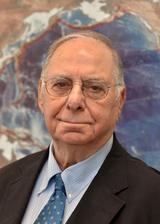Karl Turekian
Sterling Professor of Geology and Geophysics
 Karl Turekian. B.A, Wheaton College, M.A., Ph.D. Columbia University, you are a titan in the field of modern Geology and Geophysics. You are also one of the grand figures in science at Yale where, at your retirement this June, you will have been a professor for fifty-five years. At last count you had 191 publications listed in the Web of Science, and have written several classic books in geochemistry, the study of the chemical elements in their natural habitat. You are a long-standing member of the National Academy of Sciences, have not only edited scientific journals, but founded them, have ocean full of honors, such as the Goldschmidt Award and medal of the Geochemical Society, the Maurice Ewing Medal of the American Geophysical Union, and the Wollaston Medal of The Geological Society of London, and have mentored dozens of developing researchers in geochemistry, not only graduate students, but undergraduates as well, all of them now distinguished in the field.
Karl Turekian. B.A, Wheaton College, M.A., Ph.D. Columbia University, you are a titan in the field of modern Geology and Geophysics. You are also one of the grand figures in science at Yale where, at your retirement this June, you will have been a professor for fifty-five years. At last count you had 191 publications listed in the Web of Science, and have written several classic books in geochemistry, the study of the chemical elements in their natural habitat. You are a long-standing member of the National Academy of Sciences, have not only edited scientific journals, but founded them, have ocean full of honors, such as the Goldschmidt Award and medal of the Geochemical Society, the Maurice Ewing Medal of the American Geophysical Union, and the Wollaston Medal of The Geological Society of London, and have mentored dozens of developing researchers in geochemistry, not only graduate students, but undergraduates as well, all of them now distinguished in the field.
Your high-fibre scientific career can be divided into three segments. Your 1961 paper with Karl Hans Wedepohl—an inventory contrasting all elements in Earth’s crystal rocks with the chemical abundances of fallen meteorites—has garnered 1259 citations in the ISI and seeded the comprehensive Handbook of Geochemistry during 1968-71, which you yourself co-edited. In the next part of your career, you moved through the periodic table to determine chemical exchanges throughout Earth’s environment, and to use a variety of radioactive isotopes to determine the ages of rocks, the rates of biological processes in the ocean, and the transport of radiogenic nuclides in the atmosphere. During this time your Coffee Room in Kline Geology Lab became renowned for bull sessions on the blackboard every morning from 10:30am to lunch, sharpening the minds of a generation of graduate students.
In the third part of your career, you found a new love within the periodic table, osmium, Nature’s heaviest metal, a platinum-group element with a distinct meteoritic signature, enabling you and J.M. Luck to demonstrate that the mysterious clay layer found worldwide at the Cretaceous-Tertiary boundary was surely derived from an extraterrestrial impact. For more than a quarter-century you followed the relative abundances of distinct osmium isotopes from sea to shore to mountain, elucidating problems in rock weathering, volcanic chemistry, and the ages of previously un-datable black shales. Finally, you and BJ Pegram produced an oceanic history of osmium-isotope ratios that bookends your original oceanic history of strontium isotopes. Both geochemical histories capture major events in Earth history via their fingerprints in our planet’s chemical interactions.
But even this is not all. You have added a coda to your career by co-editing the nine-volume Treatise on Geochemistry with Heinrich Holland, published in 2003 and soon to be updated. In your early career, you labored to estimate the abundance of each element with a primitive emission spectrograph. In this phase of your career, when your eminence brings instant recognition, you have been able to pick up your office phone and commission entire chapters on each relevant element in Earth’s crust, ocean and atmosphere.
In 1997 your many academic friends organized a 2-day festschrift at Yale in honor of your 70th birthday. This celebration was so memorable that you now refuse to allow the Geology and Geophysics Department to stage a farewell retirement party, claiming that it could not surpass the 1997 festschrift. Perhaps it is better, in fact, that we not fete you now, since after fifty-five years, nothing would be the same without you—and this way we can simply look forward to a seamless transition and your continued company in the department you love and have served so well and so long.
Tribute Editor: Penelope Laurans